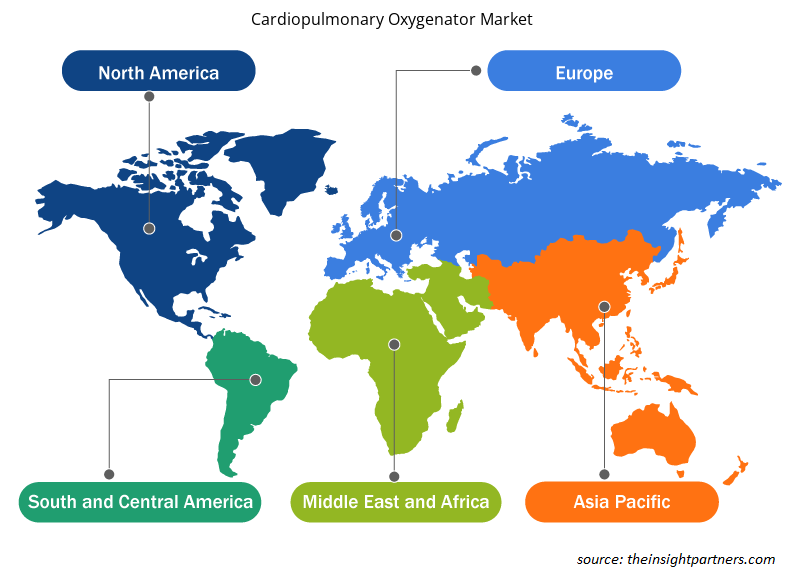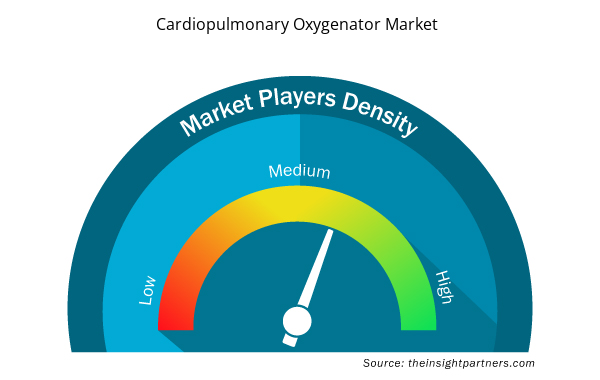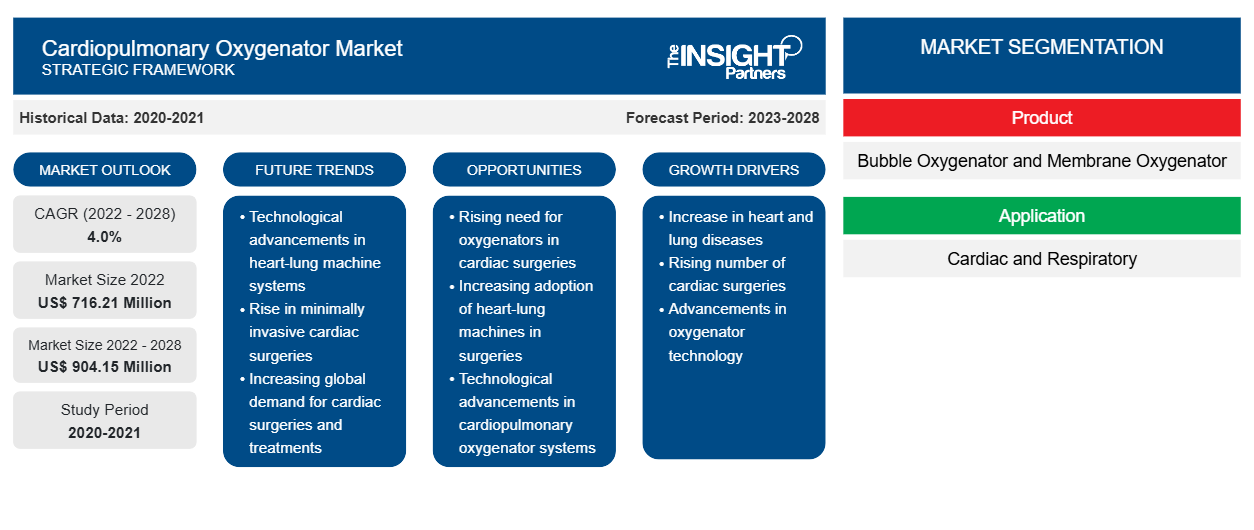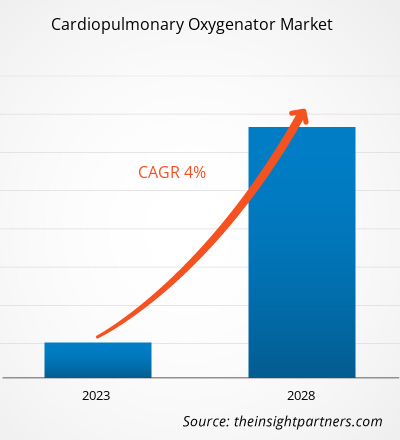[Forschungsbericht] Der weltweite Markt für kardiopulmonale Oxygenatoren soll von 716,21 Millionen US-Dollar im Jahr 2022 auf 904,15 Millionen US-Dollar im Jahr 2028 wachsen; von 2022 bis 2028 wird eine durchschnittliche jährliche Wachstumsrate (CAGR) von 4,0 % erwartet.
Im Jahr 2022 hatte Nordamerika den größten Marktanteil, wobei die USA den größten Beitrag zum Markt in dieser Region leisteten. Das Marktwachstum wird auf die steigende Prävalenz von Herz-Kreislauf- und Atemwegserkrankungen zurückgeführt, die die Inzidenz von kardiopulmonalen Erkrankungen wie COPD, chronischer Bronchitis und kongestiver Herzinsuffizienz erhöht hat. Laut der American Lung Association wurden beispielsweise im Jahr 2020 in den USA etwa 12,5 Millionen Menschen mit COPD, chronischer Bronchitis und Emphysem diagnostiziert. Darüber hinaus hat die steigende Prävalenz und Inzidenz solcher Erkrankungen die Zahl der chirurgischen Eingriffe bei einer großen Patientenpopulation erhöht, was das Wachstum des Marktes für kardiopulmonale Oxygenatoren angekurbelt hat . Laut einer vom Lifespan Health System veröffentlichten Studie werden in den USA beispielsweise jedes Jahr etwa 500.000 Operationen am offenen Herzen durchgeführt. Darüber hinaus wird erwartet, dass eine Zunahme der Prävalenz von Atemversagen und Infektionskrankheiten in den kommenden Jahren die Nachfrage nach kardiopulmonalen Oxygenatoren weiter steigern wird.
Darüber hinaus ist die steigende Prävalenz von Herz-Kreislauf-Erkrankungen die häufigste Todesursache auf globaler Ebene, und Oxygenatoren können in lebensrettenden Notfällen eine große Hilfe sein. Laut der Weltgesundheitsorganisation gehen jährlich etwa 17,9 Millionen Menschenleben durch Herz-Kreislauf-Erkrankungen verloren. Darüber hinaus wird erwartet, dass günstige Erstattungsrichtlinien in den kommenden Jahren reichlich Möglichkeiten für das Wachstum des Marktes für kardiopulmonale Oxygenatoren schaffen werden. Daher wird erwartet, dass die steigende Prävalenz und Inzidenz von kardiopulmonalen Erkrankungen das Wachstum des Marktes für kardiopulmonale Oxygenatoren im Prognosezeitraum vorantreiben wird.
Markt für kardiopulmonale Oxygenatoren –
Passen Sie diesen Bericht Ihren Anforderungen an
Sie erhalten kostenlos individuelle Anpassungen an jedem Bericht, einschließlich Teilen dieses Berichts oder einer Analyse auf Länderebene, eines Excel-Datenpakets sowie tolle Angebote und Rabatte für Start-ups und Universitäten.
- Holen Sie sich die wichtigsten Markttrends aus diesem Bericht.Dieses KOSTENLOSE Beispiel umfasst eine Datenanalyse von Markttrends bis hin zu Schätzungen und Prognosen.
Der Einsatz tragbarer ECMO-Geräte beschleunigt das Wachstum des Marktes für kardiopulmonale Sauerstoffversorgung.
Die erste ECMO- Technologie wurde seit mehr als 60 Jahren eingeführt. Das erste auf den Markt gebrachte Modell war riesig in Größe und Form. Mit der Einführung einer tragbaren Version des ECMO-Systems können Ärzte nun Patienten mit chronischer COPD oder Herzinsuffizienz ganz entspannt behandeln. Die neue tragbare Technologie ist aufgrund ihrer kompakten Größe revolutionär; sie ist auch eine ideale Wahl für die Therapie mit einem linksventrikulären Unterstützungssystem (LVAD) oder bei Lungentransplantationen. Das tragbare Gerät gibt dem Arzt genügend Zeit, um die Organsituation des Patienten zu beurteilen. Kleine tragbare Geräte sind für Patienten von Vorteil, die mehr als eine Organtransplantation erhalten. Tragbare ECMO-Geräte entwickeln sich daher zu einem futuristischen Trend auf dem Markt für kardiopulmonale Oxygenatoren. Einige ECMO-Systeme sind für den Transport innerhalb eines Krankenhauses vorgesehen, während andere für den Patiententransport zwischen Krankenhäusern bestimmt sind. Der neue Oxygenator Capiox NX19 trägt dazu bei, die Auswirkungen des kardiopulmonalen Bypasses zu minimieren, indem er die Hämodilution verringert, die Entzündungsreaktion minimiert und eine hocheffiziente Entfernung gasförmiger Mikroembolien (GME) unterstützt.
Markteinblicke – Markt für kardiopulmonale Oxygenatoren
Nach Regionen ist der Markt für kardiopulmonale Oxygenatoren in Nordamerika, Europa, Asien-Pazifik, Südamerika sowie den Nahen Osten und Afrika unterteilt. Nordamerika dominierte den Marktanteil von kardiopulmonalen Oxygenatoren im Jahr 2022. Der Markt in dieser Region ist weiter in die USA, Kanada und Mexiko unterteilt. Das Wachstum des nordamerikanischen Marktes für kardiopulmonale Oxygenatoren ist auf die steigende Prävalenz von Herz-Kreislauf- und Atemwegserkrankungen in der Region zurückzuführen. Dies hat die Inzidenz von kardiopulmonalen Erkrankungen wie COPD, chronischer Bronchitis und kongestiver Herzinsuffizienz erhöht. Laut der American Lung Association wurden beispielsweise im Jahr 2020 in den USA etwa 12,5 Millionen Menschen mit COPD, chronischer Bronchitis und Emphysem diagnostiziert. Daher wird erwartet, dass die steigende Prävalenz und Inzidenz von kardiopulmonalen Erkrankungen das Wachstum des Marktes für kardiopulmonale Oxygenatoren im Prognosezeitraum vorantreiben wird.
Produktbasierte Erkenntnisse
Basierend auf dem Produkt ist der Markt für kardiopulmonale Oxygenatoren in Membranoxygenatoren und Blasenoxygenatoren unterteilt . Das Segment der Membranoxygenatoren hatte 2022 einen größeren Marktanteil und wird im Prognosezeitraum (2022–2028) voraussichtlich eine höhere CAGR verzeichnen. Es wird erwartet, dass technologisch fortschrittliche Membranoxygenatoren das Wachstum des Marktes für kardiopulmonale Oxygenatoren im Prognosezeitraum vorantreiben werden.
Der Markt für kardiopulmonale Oxygenatoren ist nach Produkt, Anwendung, Typ, Altersgruppe und Endverbrauch segmentiert. Basierend auf dem Produkt ist der Markt für kardiopulmonale Oxygenatoren in Blasenoxygenatoren und Membranoxygenatoren unterteilt. In Bezug auf die Anwendung ist der Markt für kardiopulmonale Oxygenatoren in Herz- und Atemwege unterteilt. Basierend auf dem Typ ist der Markt in Einweg-Kardiopulmonaloxygenatoren und wiederverwendbare Kardiopulmonaloxygenatoren unterteilt. Basierend auf der Altersgruppe ist der Markt für kardiopulmonale Oxygenatoren in Erwachsene, Kinder und Neugeborene segmentiert. Basierend auf der Endnutzung ist der Markt für kardiopulmonale Oxygenatoren in Krankenhäuser und Kliniken, ambulante chirurgische Zentren und andere segmentiert. Basierend auf der Geografie ist der Markt für kardiopulmonale Oxygenatoren hauptsächlich in Nordamerika, Europa, Asien-Pazifik (APAC), Naher Osten und Afrika (MEA) und Südamerika (SAM) segmentiert.
Regionale Einblicke in den Markt für kardiopulmonale Oxygenatoren
Die regionalen Trends und Faktoren, die den Markt für kardiopulmonale Oxygenatoren im Prognosezeitraum beeinflussen, wurden von den Analysten von Insight Partners ausführlich erläutert. In diesem Abschnitt werden auch die Marktsegmente und die Geografie für kardiopulmonale Oxygenatoren in Nordamerika, Europa, im asiatisch-pazifischen Raum, im Nahen Osten und Afrika sowie in Süd- und Mittelamerika erörtert.

- Erhalten Sie regionale Daten zum Markt für kardiopulmonale Oxygenatoren
Umfang des Marktberichts über kardiopulmonale Oxygenatoren
| Berichtsattribut | Details |
|---|---|
| Marktgröße im Jahr 2022 | 716,21 Millionen US-Dollar |
| Marktgröße bis 2028 | 904,15 Millionen US-Dollar |
| Globale CAGR (2022 - 2028) | 4,0 % |
| Historische Daten | 2020-2021 |
| Prognosezeitraum | 2023–2028 |
| Abgedeckte Segmente | Nach Produkt
|
| Abgedeckte Regionen und Länder | Nordamerika
|
| Marktführer und wichtige Unternehmensprofile |
|
Marktteilnehmerdichte für kardiopulmonale Oxygenatoren: Auswirkungen auf die Geschäftsdynamik verstehen
Der Markt für kardiopulmonale Oxygenatoren wächst rasant, angetrieben durch die steigende Nachfrage der Endnutzer aufgrund von Faktoren wie sich entwickelnden Verbraucherpräferenzen, technologischen Fortschritten und einem größeren Bewusstsein für die Vorteile des Produkts. Mit steigender Nachfrage erweitern Unternehmen ihr Angebot, entwickeln Innovationen, um die Bedürfnisse der Verbraucher zu erfüllen, und nutzen neue Trends, was das Marktwachstum weiter ankurbelt.
Die Marktteilnehmerdichte bezieht sich auf die Verteilung von Firmen oder Unternehmen, die in einem bestimmten Markt oder einer bestimmten Branche tätig sind. Sie gibt an, wie viele Wettbewerber (Marktteilnehmer) in einem bestimmten Marktraum im Verhältnis zu seiner Größe oder seinem gesamten Marktwert präsent sind.
Die wichtigsten auf dem Markt für kardiopulmonale Oxygenatoren tätigen Unternehmen sind:
- Getinge AB
- LivaNova Plc
- Medtronic Plc
- Terumo Corp
- Euroset SRL
Haftungsausschluss : Die oben aufgeführten Unternehmen sind nicht in einer bestimmten Reihenfolge aufgeführt.

- Überblick über die wichtigsten Akteure auf dem Markt für kardiopulmonale Oxygenatoren
Die wichtigsten Marktteilnehmer auf dem Markt für kardiopulmonale Oxygenatoren sind Getinge AB, LivaNova Plc, Medtronic Plc, Terumo Corp, Eurosets SRL, Nipro Medical Corp, Fresenius Medical Care AG & Co. KGaA, MicroPort Scientific Corp, Braile Biomédica Industry, Commerce and Representations Ltd und Chalice Medical Ltd.
Die Akteure auf dem Markt für kardiopulmonale Oxygenatoren konzentrieren sich hauptsächlich auf die Produktzulassung und Unternehmensexpansion, um Mehrwert für den Kunden zu schaffen.
- Im November 2022 gab LivaNova PLC bekannt, dass es von der US-amerikanischen Food and Drug Administration (FDA) die 510(k)-Zulassung für die extrakorporale Membranoxygenierung (ECMO) für LifeSPARC erhalten hat, das Pumpen- und Steuerungssystem der nächsten Generation des Unternehmens zur erweiterten Kreislaufunterstützung (ACS).
- Im Februar 2022 gab Fresenius Medical Care bekannt, dass die US-amerikanische Food and Drug Administration (FDA) Novalung zugelassen hat, ein Herz- und Lungenunterstützungssystem zur Behandlung von akutem Atem- oder Herz-Lungen-Versagen. Novalung ist das erste extrakorporale Membranoxygenierungssystem (ECMO), das für eine Verwendung von mehr als sechs Stunden als extrakorporale Lebenserhaltung zugelassen ist.
- Im Dezember 2020 gab Nipro Medical Corp bekannt, dass Nipro Australia PTY LTD, seine konsolidierte Tochtergesellschaft, ein Vertriebsbüro in Melbourne, Victoria, Australien, eröffnet habe.
- Historische Analyse (2 Jahre), Basisjahr, Prognose (7 Jahre) mit CAGR
- PEST- und SWOT-Analyse
- Marktgröße Wert/Volumen – Global, Regional, Land
- Branche und Wettbewerbsumfeld
- Excel-Datensatz


- Dried Blueberry Market
- Medical Enzyme Technology Market
- Authentication and Brand Protection Market
- Electronic Shelf Label Market
- Virtual Production Market
- Wire Harness Market
- Biopharmaceutical Contract Manufacturing Market
- Genetic Testing Services Market
- Artwork Management Software Market
- Energy Recovery Ventilator Market

Report Coverage
Revenue forecast, Company Analysis, Industry landscape, Growth factors, and Trends

Segment Covered
This text is related
to segments covered.

Regional Scope
North America, Europe, Asia Pacific, Middle East & Africa, South & Central America

Country Scope
This text is related
to country scope.
Häufig gestellte Fragen
Companies operating in the market are Getinge AB, LivaNova Plc, Medtronic Plc, Terumo Corp, Eurosets SRL, Nipro Medical Corp, Fresenius Medical Care AG & Co. KGaA, MicroPort Scientific Corp, Braile Biomédica Industry, Commerce and Representations Ltd, and Chalice Medical Ltd.
Global home infusion therapy market is segmented by region into North America, Europe, Asia Pacific, the Middle East & Africa, and South & Central America. North America is likely to continue its dominance in the home infusion therapy market during 2022–2028. The US holds the largest share of the market in North America and is expected to continue this trend during the forecast period.
The cardiopulmonary oxygenators market, by application, is bifurcated into cardiac and respiratory. The cardiac segment held a larger market share in 2021 and is anticipated to register a higher CAGR during the forecast period (2022–2028).
Key factors driving the market growth are rising incidences of cardiopulmonary diseases and increasing surgical procedures with surging in aging population.
The cardiopulmonary oxygenators market, by product, is bifurcated into membrane oxygenator and bubble oxygenator. The membrane oxygenator segment held a larger market share in 2021 and is anticipated to register a higher CAGR during the forecast period (2022–2028).
The oxygenator removes carbon dioxide and adds oxygen to the blood that is pumped into the arterial system. The blood pumped back into the patient’s arteries is sufficient to maintain life at even the most distant parts of the body as well as in the organs. Cardiopulmonary bypass (CPB) procedures require a blood-gas exchanger (oxygenator) to replace the respiratory function of the lungs temporarily. In the past the majority of CPB procedures have been carried out with bubble oxygenators which effect gas exchange by dispersion of bubbles into the blood. Membrane oxygenators, on the other hand, utilize a hydrophobic gas permeable membrane between the blood and gas phases. Bubble oxygenators are being superseded by membrane types for CPB due to improvements in membrane technology and mass transfer efficiency.
Trends and growth analysis reports related to Life Sciences : READ MORE..
The List of Companies - Cardiopulmonary Oxygenator Market
- Getinge AB
- LivaNova Plc
- Medtronic Plc
- Terumo Corp
- Eurosets SRL
- Nipro Medical Corp
- Fresenius Medical Care AG & Co. KGaA
- MicroPort Scientific Corp
- Braile Biomédica Industry, Commerce and Representations Ltd
- Chalice Medical Ltd.
The Insight Partners performs research in 4 major stages: Data Collection & Secondary Research, Primary Research, Data Analysis and Data Triangulation & Final Review.
- Data Collection and Secondary Research:
As a market research and consulting firm operating from a decade, we have published and advised several client across the globe. First step for any study will start with an assessment of currently available data and insights from existing reports. Further, historical and current market information is collected from Investor Presentations, Annual Reports, SEC Filings, etc., and other information related to company’s performance and market positioning are gathered from Paid Databases (Factiva, Hoovers, and Reuters) and various other publications available in public domain.
Several associations trade associates, technical forums, institutes, societies and organization are accessed to gain technical as well as market related insights through their publications such as research papers, blogs and press releases related to the studies are referred to get cues about the market. Further, white papers, journals, magazines, and other news articles published in last 3 years are scrutinized and analyzed to understand the current market trends.
- Primary Research:
The primarily interview analysis comprise of data obtained from industry participants interview and answers to survey questions gathered by in-house primary team.
For primary research, interviews are conducted with industry experts/CEOs/Marketing Managers/VPs/Subject Matter Experts from both demand and supply side to get a 360-degree view of the market. The primary team conducts several interviews based on the complexity of the markets to understand the various market trends and dynamics which makes research more credible and precise.
A typical research interview fulfils the following functions:
- Provides first-hand information on the market size, market trends, growth trends, competitive landscape, and outlook
- Validates and strengthens in-house secondary research findings
- Develops the analysis team’s expertise and market understanding
Primary research involves email interactions and telephone interviews for each market, category, segment, and sub-segment across geographies. The participants who typically take part in such a process include, but are not limited to:
- Industry participants: VPs, business development managers, market intelligence managers and national sales managers
- Outside experts: Valuation experts, research analysts and key opinion leaders specializing in the electronics and semiconductor industry.
Below is the breakup of our primary respondents by company, designation, and region:

Once we receive the confirmation from primary research sources or primary respondents, we finalize the base year market estimation and forecast the data as per the macroeconomic and microeconomic factors assessed during data collection.
- Data Analysis:
Once data is validated through both secondary as well as primary respondents, we finalize the market estimations by hypothesis formulation and factor analysis at regional and country level.
- Macro-Economic Factor Analysis:
We analyse macroeconomic indicators such the gross domestic product (GDP), increase in the demand for goods and services across industries, technological advancement, regional economic growth, governmental policies, the influence of COVID-19, PEST analysis, and other aspects. This analysis aids in setting benchmarks for various nations/regions and approximating market splits. Additionally, the general trend of the aforementioned components aid in determining the market's development possibilities.
- Country Level Data:
Various factors that are especially aligned to the country are taken into account to determine the market size for a certain area and country, including the presence of vendors, such as headquarters and offices, the country's GDP, demand patterns, and industry growth. To comprehend the market dynamics for the nation, a number of growth variables, inhibitors, application areas, and current market trends are researched. The aforementioned elements aid in determining the country's overall market's growth potential.
- Company Profile:
The “Table of Contents” is formulated by listing and analyzing more than 25 - 30 companies operating in the market ecosystem across geographies. However, we profile only 10 companies as a standard practice in our syndicate reports. These 10 companies comprise leading, emerging, and regional players. Nonetheless, our analysis is not restricted to the 10 listed companies, we also analyze other companies present in the market to develop a holistic view and understand the prevailing trends. The “Company Profiles” section in the report covers key facts, business description, products & services, financial information, SWOT analysis, and key developments. The financial information presented is extracted from the annual reports and official documents of the publicly listed companies. Upon collecting the information for the sections of respective companies, we verify them via various primary sources and then compile the data in respective company profiles. The company level information helps us in deriving the base number as well as in forecasting the market size.
- Developing Base Number:
Aggregation of sales statistics (2020-2022) and macro-economic factor, and other secondary and primary research insights are utilized to arrive at base number and related market shares for 2022. The data gaps are identified in this step and relevant market data is analyzed, collected from paid primary interviews or databases. On finalizing the base year market size, forecasts are developed on the basis of macro-economic, industry and market growth factors and company level analysis.
- Data Triangulation and Final Review:
The market findings and base year market size calculations are validated from supply as well as demand side. Demand side validations are based on macro-economic factor analysis and benchmarks for respective regions and countries. In case of supply side validations, revenues of major companies are estimated (in case not available) based on industry benchmark, approximate number of employees, product portfolio, and primary interviews revenues are gathered. Further revenue from target product/service segment is assessed to avoid overshooting of market statistics. In case of heavy deviations between supply and demand side values, all thes steps are repeated to achieve synchronization.
We follow an iterative model, wherein we share our research findings with Subject Matter Experts (SME’s) and Key Opinion Leaders (KOLs) until consensus view of the market is not formulated – this model negates any drastic deviation in the opinions of experts. Only validated and universally acceptable research findings are quoted in our reports.
We have important check points that we use to validate our research findings – which we call – data triangulation, where we validate the information, we generate from secondary sources with primary interviews and then we re-validate with our internal data bases and Subject matter experts. This comprehensive model enables us to deliver high quality, reliable data in shortest possible time.


 Holen Sie sich ein kostenloses Muster für diesen Bericht
Holen Sie sich ein kostenloses Muster für diesen Bericht